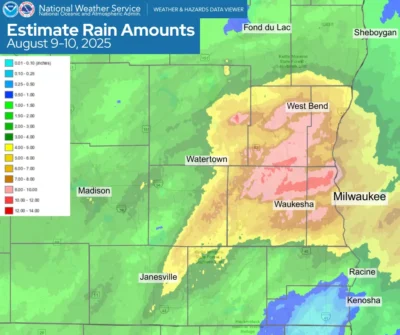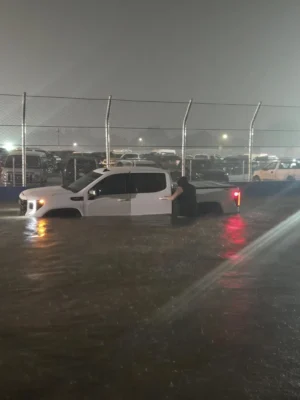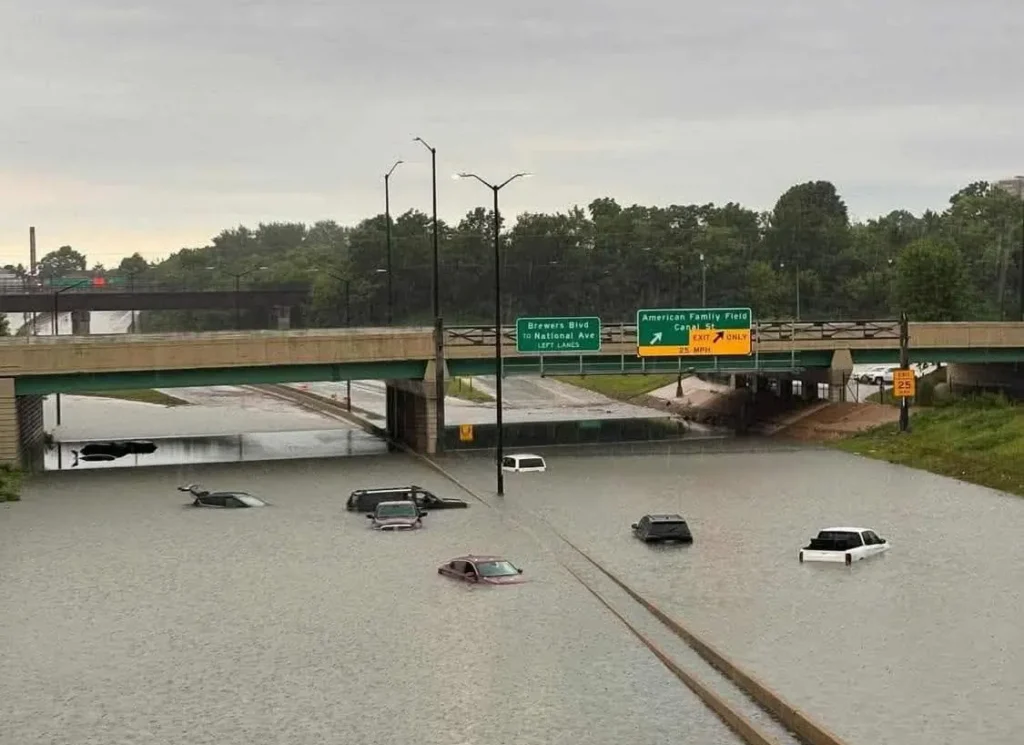On the evening of Saturday, August 9, thunderstorms and torrential downpours moved into southeastern Wisconsin. As the night went on, the rain continued to fall at rates of one to two inches per hour, causing the worst flash flooding event in the region since 2008.
Atmospheric Set Up
A weak disturbance shifted through southern Wisconsin during the afternoon of August 9, sparking showers and thunderstorms. High humidity, combined with an inflow of moisture from the southwest provided by the low-level jet, created a saturated environment for thunderstorms to pull from. This allowed for what normally would have been steady rain showers to escalate into a deluge.
Weather balloon launches on Saturday from the National Weather Service Offices in Minneapolis and Green Bay showed these atmospheric dynamics, allowing the National Weather Service in Milwaukee to communicate flooding concerns ahead of time.
As the storms moved in, a Mesoscale Convective Vortex (MCV), a localized center of low pressure within the larger storm system, aided in fueling additional downpours into the early hours of August 10.
The (Preliminary) Totals

The heaviest rain fell across Waukesha, Washington, Milwaukee, and Ozaukee Counties. Widespread rainfall totals from August 9 to 10 ranged from five to ten inches in those counties.
The historical average rainfall for Waukesha County in August is 3.84 inches. The county’s wettest August was in 2007, when the county-wide average rainfall measured 10.06 inches.
| Preliminary Rain Reports for August 9-10, 2025 | |
| Location | Reported Rain Total |
| Pewaukee (Waukesha Co.) | 12.61″ |
| Butler (Waukesha Co.) | 12.22″ |
| Menomonee Falls (Waukesha Co.) | 12.05″ |
| New Berlin (Waukesha Co.) | 11.75″ |
| NW Milwaukee | 11.71″ |
| Brookfield (Waukesha Co.) | 11.26″ |
| Germantown (Washington Co.) | 10.58″ |
| West Bend (Washington Co.) | 10.10″ |
| Port Washington (Ozaukee Co.) | 9.19″ |
| Oconomowoc (Waukesha Co.) | 9.00″ |
| West Allis (Milwaukee Co.) | 8.94″ |
| Milwaukee (MKE) | 6.91″ |
| Preliminary rainfall reports in southeast Wisconsin from August 9-10. 2025. Source: SC ACIS and the National Weather Service in Milwaukee. | |
Setting New Records
One location on the northwest side of Milwaukee reported a 24-hour rain total of 14.5 inches on August 9. That report will need to be verified by the State Climate Extremes Committee to determine if it is a new state record for the largest single-day rainfall. The verification process may take weeks or months to complete.
The long-standing 24-hour rain record in the state is 11.72 inches in Mellen (Ashland County) that fell on June 24, 1946.
| Wisconsin’s Single-Day Rain Records | ||
| Location | Rain Total | Date |
| Mellen (Ashland Co.) | 11.72″ | June 24, 1946 |
| Butler (Waukesha Co.) | 11.64″ | August 9, 2025 |
| W. Madison (Dane Co.) | 11.63″ | August 20, 2018 |
| New Berlin (Waukesha Co.) | 11.37″ | August 9, 2025 |
| Menomonee Falls (Waukesha Co.) | 11.29″ | August 9, 2025 |
| Brookfield (Waukesha Co.) | 11.25″ | August 9, 2025 |
| W. Madison (Dane Co.) | 11.19″ | August 20, 2018 |
| Wisconsin’s highest 24-hour rainfall totals with records dating back as early as 1869. Bolded totals from August 2025 indicate that these reports are preliminary and may be adjusted. Source: SC ACIS. | ||
The Milwaukee Mitchell International Airport measured 5.74 inches of rain on August 9 — more than the city’s average total for the entire month of August! This smashed Milwaukee’s previous rainfall record for August 9 of 1.64 inches that was set in 1960.
This marked the second-largest single-day rainfall in Milwaukee since the city’s records began in 1871. This was only the 11th time since 1871 that Milwaukee has received more than four inches of rain in one day; seven of those events have occurred in the last 30 years.
| Milwaukee’s Single-Day Rain Records | |
| Rain Total | Date |
| 6.81″ | August 6, 1986 |
| 5.74″ | August 9, 2025 |
| 5.61″ | July 22, 2010 |
| 5.40″ | June 23, 1917 |
| 4.93″ | June 7, 2008 |
| The largest single-day rain events in the Milwaukee area, with records beginning in 1871. Source: NOAA’s NOWData. | |
Overflowing the Banks
The rivers and streams in southeast Wisconsin quickly breached their banks.
In Waukesha County, the Menomonee River at Menomonee Falls reached a record height of 8.52 feet in the early morning of August 10, exceeding the previous record crest of 8.31 feet set on June 21, 1997.
The Milwaukee River reached a new record high of 11.19 feet at Estabrook Park in Shorewood, just north of Milwaukee. The previous record was 10.48 feet on July 22, 2010.
The Root River at Franklin reached a new all-time high of 11.71 feet, exceeding the previous record of 11 feet from July 8, 2008. Emergency responders rescued a teen from the river on August 10, after he had been pulled 100 yards downstream from where he had entered the water.

The Impacts
It didn’t take long for water to begin piling up as sewers and drains became overloaded with the heavy rain.
The Wisconsin State Fair in West Allis closed the grounds early and cancelled the Lynyrd Skynyrd Main Stage performance as water began to pond inside the fairgrounds. As fairgoers exited the grounds, they encountered deep water up to the headlights of vehicles.
The roof of American Family Field began to leak as the Milwaukee Brewers were playing the New York Mets. As fans left the game, many became stranded on nearby roads — some were even forced to escape their vehicles through the sunroof.
Numerous roadways in Milwaukee and Waukesha County were multiple feet underwater, fully submerging cars that were parked along the curbs. Water poured into parking garages and the basements of homes. Operators at the Milwaukee Mitchell International Airport reported that only one runway remained above the flood waters.
According to the Wisconsin Department of Transportation, portions of Interstates 43, 41, and 94 had to remain closed on August 10 due to the flooding.

Some roadways in Muskego and Menomonee Falls were washed out as the floodwaters receded.
The Milwaukee Fire Department responded to over 600 calls between Saturday evening and Sunday morning. Milwaukee County Executive David Crowley announced a State of Emergency for Milwaukee County, and Governor Tony Evers approved National Guard assistance in the county, subsequently declaring a State of Emergency.
On Sunday, August 10, the Wisconsin State Fair grounds remained closed to allow for clean-up, and the USA triathlon national championships scheduled to take place in Milwaukee were cancelled. The Brewers game went on as planned, despite parking lots remaining underwater.
This information is preliminary and may be updated as new data and reports are submitted. This article will be updated with the newest information as it becomes available to us.
This is a product of the Wisconsin State Climatology Office. For questions and comments, please contact us by email (stclim@aos.wisc.edu) or phone (608-263-2374).